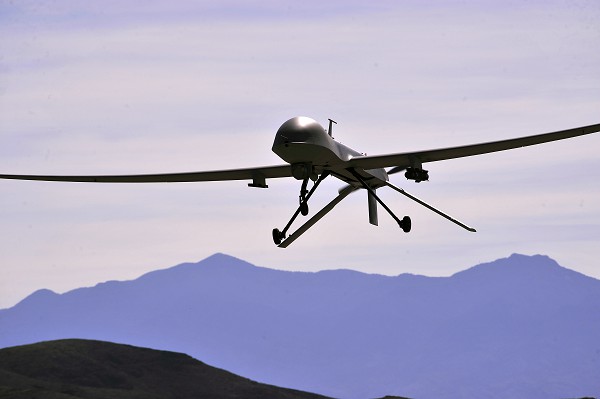 Creech Air Force Base, Indian Springs, NV. (October 18, 2022). In this photo by Senior Master Sergeant Paul Holcomb, an MQ-1B Predator remotely piloted aircraft passes over the airfield during a recent training mission. Part of the 432nd Air Expeditionary Wing, Predators conduct surveillance, reconnaissance, and close air support for America’s warfighters around the world.
Creech Air Force Base, Indian Springs, NV. (October 18, 2022). In this photo by Senior Master Sergeant Paul Holcomb, an MQ-1B Predator remotely piloted aircraft passes over the airfield during a recent training mission. Part of the 432nd Air Expeditionary Wing, Predators conduct surveillance, reconnaissance, and close air support for America’s warfighters around the world.
Creech Air Force Base, Indian Springs, NV. (October 18, 2022). Some say the American fighter pilot will soon be replaced by unmanned aerial vehicles (UAVs), pilotless warplanes operated from air-conditioned bunkers thousands of miles from the enemy. No offense to fans of Top Gun, but to servicemembers fighting on the ground, these UAVs offer protection and attack capability that is truly inhuman.
The MQ-1B Predator is an armed, multi-mission, medium-altitude, long-endurance remotely piloted aircraft that is employed primarily as an intelligence-collection asset and secondarily as an attack aircraft against long range targets. Manufactured by General Atomics Aeronautical Systems Inc., the Predator affords ground commanders the luxury of armed reconnaissance of the battlefield with the ability to identity and target enemy positions with two laser guided AGM-114 Hellfire missiles. This baby flies up to 135 mph, has a range of 770 miles, and is flown by a qualified pilot and a sensor operator to monitor imaging and targeting. The Predator is deployed and recovered on a standard 5,000-foot runway and has a maximum take off weight of over two thousand pounds (fuel and armament).
The chief advantage of the Predator, in addition to advanced optics, is its ability to “loiter” above a given target for up to 14 hours, something that is simply impossible with existing attack fighters and crews. Typically, the Predator is loaded unassembled into a C-130 transport aircraft and shipped to within range of the battle accompanied by a small operations crew to reassemble and launch it. Once airborne, pilots and tactical controllers in the United States take over the mission.
Predator operators train at Fort Huachuca, Arizona in a 32-week course that combines classroom and “in the field” flights against simulated targets. The training is conducted by the Army’s 2-13th Aviation Regiment and the school graduates about 2,000 soldiers, Marines, and foreign military students annually.
While some pilots may resent the idea of being replaced by UAVs, the drones are preferable because human pilots experience fatigue on long missions or may be put in danger during high threat missions. The Predator protects both pilots and troops on the ground by providing real-time reconnaissance and surveillance coupled with the ability to strike targets despite threats from enemy fire.
Our servicemembers count on the Predator to have their back in combat. Can they count you to contribute to Support Our Troops, a national charity that delivered over $40 million of tangible support to America’s military servicemembers last year. Donors should know that 97 percent of every dollar they give is spent on services to the troops. By contributing to Support Our Troops’ Patriot Brigade®, you will join thousands of Americans who make monthly donations to pay for comfort items and recreational programs for our military deployed overseas. Please go to our secure website https://supportourtroops.org/donate to contribute to America’s finest today!


